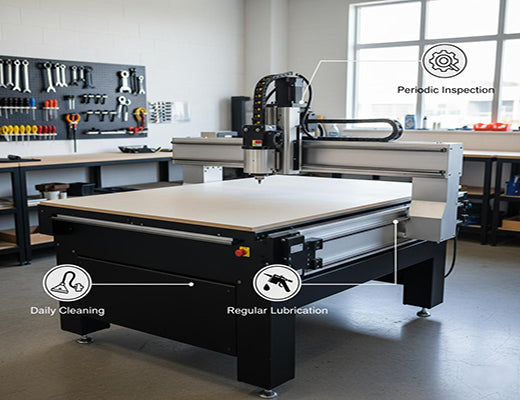
Basic CNC Router Maintenance: Tips for Longevity and Performance
|
|
Time to read 5 min
|
|
Time to read 5 min
This guide provides essential tips for basic CNC router maintenance. Just like any precision tool, your CNC router requires regular care to ensure its longevity, maintain cutting accuracy, and operate safely. We'll cover the simple yet critical tasks of cleaning, lubrication, and inspection that form the foundation of any good preventive maintenance routine, helping you protect your investment and keep your machine performing at its best.
Regular, basic CNC router maintenance is the easiest way to prevent costly repairs and ensure consistent cutting quality.
The three pillars of basic maintenance are: thorough Cleaning, proper Lubrication of moving parts, and regular Inspection of key components.
Neglecting maintenance leads to premature wear, loss of accuracy, increased risk of component failure, and potential safety hazards.
Following a simple routine takes only minutes but can add years to your machine's life and save thousands in the long run.
You've invested in a powerful CNC router. It's the heart of your workshop, turning digital designs into physical reality. But like any high-performance machine, it needs regular care to keep running optimally. Ignoring basic maintenance is like driving a car without ever changing the oil – eventually, something expensive is going to break.
Let's be clear: you don't need to be a master technician to perform essential upkeep. A few simple, regular CNC router maintenance tasks can make a world of difference. This guide will walk you through the basics.

Skipping basic maintenance is a false economy. Here's why:
This is the single most important habit. Dust and chips are the enemy.
Moving parts need lubrication to fight friction and wear. Your machine's manual is the ultimate guide here.
Take a few minutes to visually inspect key parts.
The business end of your CNC router needs attention too.
Connecting industrial machines for CNC router monitoring, often via gateways like the EG5120, can help track usage hours to better schedule maintenance, but it doesn't replace these essential physical checks.

Basic CNC router maintenance is not a chore; it's an investment. By dedicating just a few minutes each day or week to these simple tasks—cleaning, lubricating, and inspecting—you are actively protecting your valuable equipment, ensuring the continued accuracy of your cuts, enhancing safety, and ultimately saving yourself significant time and money in the long run. A well-maintained CNC router is a happy, productive, and profitable machine.

A1: Cleaning should ideally be done after every significant use. Lubrication frequency depends heavily on your machine's design and usage – check your manual, but weekly checks are a good starting point for heavily used machines. Inspections can typically be done weekly or monthly.
A2: Always refer to your machine manufacturer's manual. Using the wrong type of grease or oil can be worse than using none at all. Common types include specific ISO viscosity grade oils or NLGI grade greases, but the exact specification is crucial.
A3: Signs include: unusual noises (grinding, squealing), increased vibration during cuts, visible damage to components (cracked belts, dented rails), loss of accuracy (parts not dimensionally correct), or frequent machine errors/alarms. If you notice these, it's best to stop using the machine and consult a professional technician or the manufacturer.